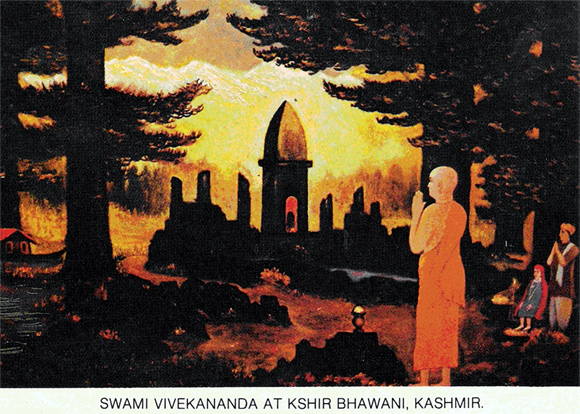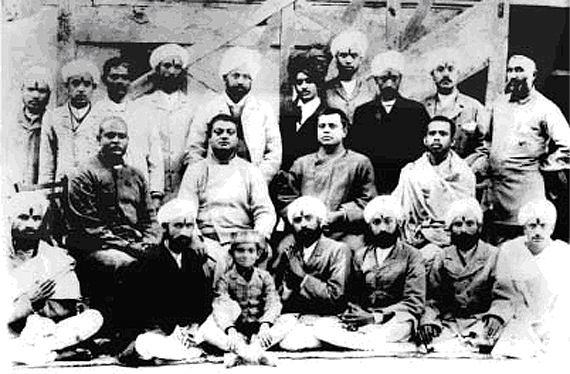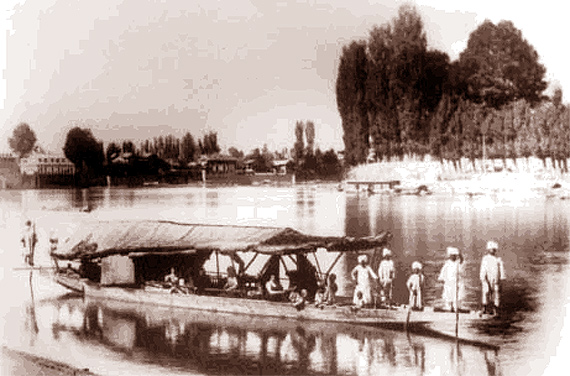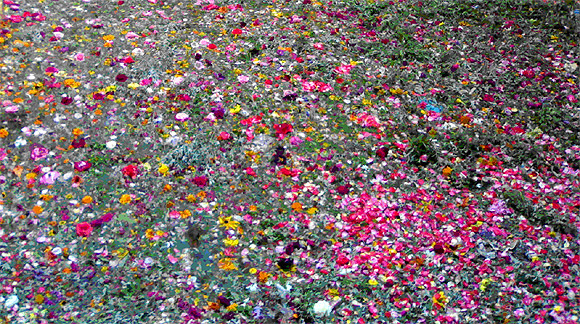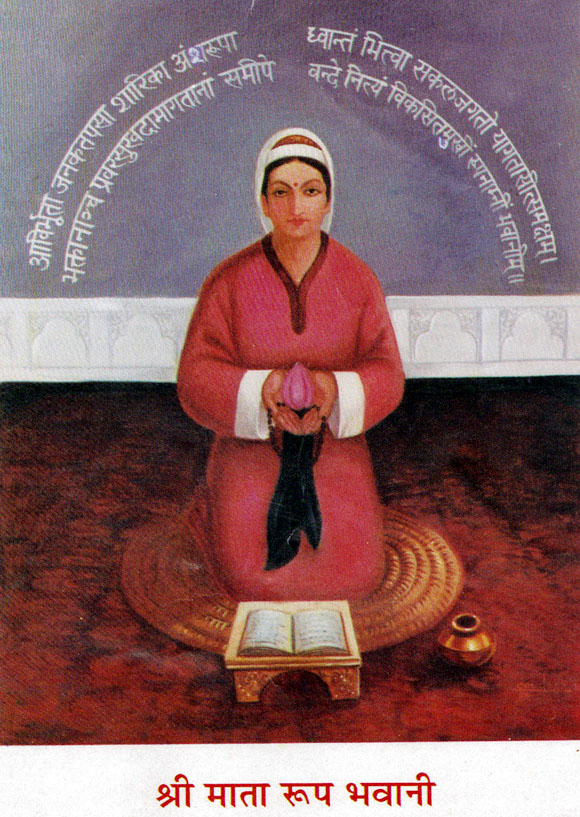
Shri Alakheshvari Roopa Bhavani
*Dr Chaman Lal Raina |
|
आविर्भूता जनक तपसा शारिका अंशरूपा
ध्वान्तं भित्वा सकल जगतो यागतासीत्समक्षम्। भक्ताञ्च प्रवरसुखदामागतानां समीपे वन्दे नित्यं विकसितमुखीं रूपनाम्नीं भवानीम्॥ aavirbhuutaa janaka tapasaa shaarikaa aMsharuupaa dhvaaantaM bhitvaa sakala jagato yaagataasiitsamaxam. bhaktaa~ncha pravarasukhadaamaagataanaaM samiipe vande nityaM vikasitamukhiiM ruupanaamniiM bhavaaniim.
Translation of the Dhyaana Shloka runs as:
" Always meditate uponthe sacred name of Shri Roopa Bhavani, who incarnated through the tapasya--austerities and spiritual quest of Her father, as the Amsha-Roopa--a portion of Jagat Mata Shri Sharika. She descended with all bloomed face to shower the blessings of Prakash/spiritual enlightenment and to remove Avidya/ignorance and delusion,who take refuge in her,as being the Bhaktas/devotee." Kashmir is the cradle of spirituality, where a blend of Shaiva and Shakti was adopted to realize the Supreme Reality in the early religious thought of Kashmir. Shaivism became an intellectual discipline, but Shaktivad became more prominent, because of the vibrant view of Prakriti/ Mother nature around the valley of Kashmir. Shakti is adored as the Shri Raginya at Tullamula in the form of mystic spring, Shri Sharika at Hari Parbat on the rock of a hillock , Shri Jwala at Khrew on the rock of the hillock, Shri Bhadrakali at Handwara area in the form of Devadaroo/pine tree , Shri Bala at Balahama in the form of Devadaroo tree,Shri Tripura at Qarfali Mohalla in the form of a well, Shri Mahakali at FatehKadal-ZainaKadal in the form of mystic spring on the banks of the Vitasta(Jehlum). Shri Tripura Sundari is in the form of the mystic spring,at Divasar . Shri Sharada at Sharada Peetha in the form of mystic Yantra on a rock, now under POK. All these manifestations are but the representations of Divine Mother either in a rock or water or tree, but Shri Sharika incarnated her Divine effulgence in the form of a female baby born of the parentage of Shri Madhav Joo Dhar of the Khankahi-Sokta at Safa kadal on the most sacred day of the Jyashthha Purnima in the 4696th year of the Saptarshi era corresponding to1677 Bikrami and 1621 A.D. It is said that she lived full one hundred years and left her mortal frame to fulfill the principle of the law of nature with respect to life and death on the Magha Krishna Saptami in the year 1777 A.D. This year we are celebrating Roopa Bhavani’s 233rd Nirvana Diwas, on the 6th of January1st February .This sacred Tithi is revered as the "Sahiban Hunz Satam". |
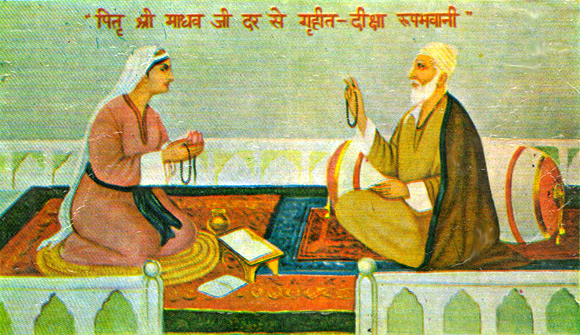 |
|
She
is the Divine manifestation of the Bija Sapta Akshari Mantra/ Mystic
seven syllabled Mantra of the Divine Mother Sharika. The Mantra runs as:
Aum Hrim Shrim Hum Fraam Aam Shaam- Shaarikaayai Namah.
ॐ ह्रीं श्रीं हुं फ्रां आं शां श्री शारिकायैनमः॥
Prefix
Aum and suffix Namah are the prerequisites to invoke any Mantra. Aum is
the Vedic Pranava and Namah is the prostrations before the Deity in
both the Vedic and Tantrik way of worship .This is known as the Samputa
Mantra of Shri Sharika. This Mantra has been invoked for attaing
Siddhi/spiritual perfection from the ancient times,in Kashmir. This is
the Maha -Mantra and the Siddha -Mantra along with the Gayatri Mantra.
Pandit Madhav Joo Dhar was the Sapta Bija Mantra Siddha Purusha, which
made Divine Mother Shri Sharika to descend in his home,through his
Shradha/unquestioned faith and Bhakti/devotion to Shri Sharika. Pandit
Madhav Joo Dhar was as blessed . He became the father of the female
child to be adored as Roopa Bhavani/R'opa Bhava'inya.Every time the
father would feel the Divine presence of Shri sharika in her.
Roopa Bhavani literally means the Form of the Primordial Mother Bhavani.Roopa means form, and Bhavani means the Mother creatrix. The source of Poorna-Prakriti as Bhavani is found in the Rudryamala Tantra, as well in the Bhavani Sahsra Naama. Roopa Bhavani was raised in the then prevalent Kashmiri Pandit religioue ethos and atmosphere. She was initiated into the Sharika Mantra by her own father, as said by Roopa Bhavani in the Rahasyopdesha.
रने आयसलल्लीश्वरस
श्री सत् ग्वरस माधवाशिवस्॥ sharane aayasa lalliishvarasa shrii sat gvarasa maadhavaa shivas.
It
says : "I have descended to submit at the feet of Lalleshvari,Shri
SatGuru Madhava and Shiva." They are all One in essence.She is in the
Advaita state of spiritual existence with Shri Lalleshvari, her Father
turned as Guru Madhav Joo and the Supreme Shiva as the Eternal
Prakash/light.She considers Yoga with Bhakti as the spiritual links to
be in tune with the Eternal Brahman, which is verily,the Nirvana state
of mind.
Divine Roopa Bhavani was initiated mysteriously into Yoga by Shri Lalleshvari- Lall Ded , through her Spiritual vibrations, which is but the Yogic mystery. Lall Ded had already passed away then . The Yogis do it at their free-will, this is known as the Anirvachaniya Shabda Yoga , in the Shakta Agamas. This state of communication is purely mystic and can not be explained in words. Sri Aurobindo was also initiated into Yoga by Swami Vivekannda , though Swami Vivekananda had already left his mortal frame then. Yogis transcend time and place. Why Shri Roopa Bhavani pays Her obeisance to Lord Shiva, Lalleshvari and Guru Madhav Joo Dhar? Shri Roopa Bhavani reveals:
करि सिरिय व्यदय .चलिगटकारुय
The
darkness of ignorance will vanish,and the Sun of knowledge will lead us
to the Sahaj Vichaara. This innate reflection of the Immutable Shiva is
the very essence of the Divine knowledge.सहज़ व्य.चार तथसारबूद॥ kari siriya vyadaya chali gaTakaaruya' sahaza vyachaara tatha saarabuuda. The interaction between Ichha- Kriya and Gyana Shakti in the Tantras of Kashmir known as the quintessential of Shaktivad. Shri Roopa Bhavani is not different from Lalleshvari, Shri Madhava and Shiva. They are all One in the essential nature of Atman’ --being the Supreme spirit, the pure essence of the Brahman of the Upanishads. It is the core message of the Rahasya Upadesha to understand the Sat Chit Ananda. Her blessings are filled up with deep love and compassion. She Says:
सथ् ना असतु अछिन्नदारम्।
सूक्ष्मो समादि परं ब्रह्मसोहम्॥ sath naa asatu aChinnadaaram. suuxmo samaadi paraM brahma soham.
The
Absolute is beyond Truth and untruth. It is infinite in nature. It is
an integral experience, wherein the Atman--the subject, Ishta/the object
and Anubhava--experince get fused into One and only one. The
Samadhi should be very minute , which can be experienced within the
experince of Brahman, which is one's own self. That is Soham--"Iam That".,being the Maha -Vakya of the Upanishads.
As a human being , she excelled in the Divine knowledge .As a great Kashmiri Pandit Woman , she preserved the great heritage of Pandit culture of "Sezar -Pazar and Shvazar." She suffered in a way, as the incarnations do suffer, when they take the kuman form,eg Shri Sita--the incarnation of Bhu Devi. She was subjected to harassment by her mother- in-law, as they did not realise her Divine presence. Her gospel is revered as the SHRI ROOPA BHAVANI RAHASYA UPADESHA. She pays homage to the Guru, followed by the Nirvana Dasha Shloki Stvah, Vakya Manjari, Sva Anubhava Ullasa Dashkam, Antar Drishti. In all, Shri Roopa Bhavani has revealed 146 Shlokas, which are Yogic in spirit, Upanishadic in thought, mystic in experience and spiritual in essence. She wanted to lift the humanity from the narrow caste system, superstition, bondage and unnecessary rituals. She preached brother hood of humanity, moral values and her spiritual revelation is to help the humanity through dedication. She says in the Antardrishti of the Rahasya Upadesha:
बूयो न बीज़म तोया नतीज़म
वायु न आकाशम् अवाताहसर्वम्। न ज़ि ब्रह्माण्डम न छ खात्म आत्मम् शक्ति स्वरूपम् परम् ब्रह्मसोहम्॥ buuyo na biizama ,toyaa na tiizama vaayu na aakaasham avaataaha sarvam. na zi brahmaaNDama na Cha khaatma aatmam shakti svaruupam param brahma soham. Her abode of Tapasya / austerities happened to be the Hari Parbat, Wotshan, Lar, Cheshma-i-Sahibi and Waskura. Her mystic Shlokas can be viewed on the Vedic and Upanishadic patterns. People revere her and is being adored with all love and dedication. May She bless all! *Images provided by Dr. Chamanlal Raina from his book titled 'Shri Roopa Bhavani Rahasyopdesha' written for Shri Alak Sahiba Trust. |



